Numerical analysis of geometric shapes of energy-efficient complexes with integrated wind turbines
- Autores: Khazov P.A.1, Vediaikina O.I.1, Konovalova V.A.1, Starikova M.V.1, Shilov S.S.1
-
Afiliações:
- Nizhny Novgorod State University of Architecture and Civil Engineering
- Edição: Nº 10 (2025)
- Páginas: 69-75
- Seção: Articles
- URL: https://gynecology.orscience.ru/0044-4472/article/view/695929
- DOI: https://doi.org/10.31659/0044-4472-2025-10-69-75
- ID: 695929
Citar
Texto integral
Resumo
The article is about the analysis of the various cross-sectional shapes of energy-efficient high-rise buildings towers equipped with integrated wind turbines influence on their aerodynamic parameters. Three variants of the tower base plan shape are proposed: rectangular, triangular and triangular with rounded corners. Modeling of the models aerodynamic flow was simulated in the ANSYS software and computing complex using the ANSYS CFX computational fluid dynamics module for two wind attack directions of 0о and 45о to the main facade. A comparative analysis of the high-rise complex towers models was carried out to identify the optimal configuration ensuring the stable air flow formation in the wind turbines vicinity and maximizes energy production. It was found that the triangular cross-section with rounded corners of the tower provides the best combination of aerodynamic characteristics, power generation efficiency and minimizes the vortex shedding likelihood.
Texto integral
Sobre autores
P. Khazov
Nizhny Novgorod State University of Architecture and Civil Engineering
Autor responsável pela correspondência
Email: khazov.nngasu@mail.ru
Doctor of Sciences (Engineering)
Rússia, 65, Ilyinskaya Street, Nizhny Novgorod, 603000O. Vediaikina
Nizhny Novgorod State University of Architecture and Civil Engineering
Email: razvnauki@rambler.ru
Candidate of Sciences (Physics and Mathematics)
Rússia, 65, Ilyinskaya Street, Nizhny Novgorod, 603000V. Konovalova
Nizhny Novgorod State University of Architecture and Civil Engineering
Email: K0n0val0vaVika@yandex.ru
Student
Rússia, 65, Ilyinskaya Street, Nizhny Novgorod, 603000M. Starikova
Nizhny Novgorod State University of Architecture and Civil Engineering
Email: marina.starick0va@yandex.ru
Student
Rússia, 65, Ilyinskaya Street, Nizhny Novgorod, 603000S. Shilov
Nizhny Novgorod State University of Architecture and Civil Engineering
Email: sergey.shilov.1997@mail.ru
Postgraduate Student
Rússia, 65, Ilyinskaya Street, Nizhny Novgorod, 603000Bibliografia
- Asrar K., Okolnikova G.E., Hesam A.A.R., Svintsov A.P. On the role of nanotechnology in the construction industry and energy efficiency of buildings. International Research Journal. 2021. No. 5–1 (107), рр. 125–131. EDN: WSJJNI. https://doi.org/10.23670/IRJ.2021.107.5.020
- Sarbaeva N.M., Omurbekova M.O., Jeenbaev U.K. The problems of increasing energy efficiency in residential buildings. The Herald of Kyrgyz state university of construction, transport and architecture named after N.Isanov. 2021. No. 1 (71), рр. 142–146. EDN: HNTGWG. https://doi.org/0.35803/1694-5298.2021.1.142-146
- Olen’kov V.D., Kolmogorova A.O., Sapogova A.E. Determination of the coefficients of transformation of the air flow when exposed to a single building using computer modeling technologies. Vestnik of the South Ural State University. Construction and Architecture. 2019. Vol. 21. No. 1, pp. 5–12. (In Russian). EDN: YJXEZG. https://doi.org/10.14529/build210101
- Khazov P.A., Shilov S.S. Geometrical optimization of aerodynamics of a high-rise building with integrated wind turbines. Vestnik of the South Ural State University. Construction and Architecture. 2024. No. 3, pp. 73–82. (In Russian). EDN: VJYQQC. https://doi.org/10.14529/build240307
- Erofeev V.I., Satanov A.A., Hazov P.A., et al. Rational orientation of facilities with integrated wind turbines according to the criterion of maximizing the generated electricity. Mashinostroyeniye i inzhenernoye obrazovaniye. 2023. No. 4 (73), pp. 39–46. (In Russian). EDN: EOQUZZ. https://doi.org/10.52261/18151051_2023_3_39
- Vediaikina O.I., Konovalova V.A., Starikova M.V., Khazov P.A., Satanov A.A. Aerodynamics of high-altitude complexes with integrated wind generating units. Zhurnal teoreticheskoy i prikladnoy mekhaniki. 2025. No. 1 (90), pp. 62–72. (In Russian). EDN: BKLZOE. https://doi.org/10.24412/0136-4545-2025-1-62-72
- Lampsi B.B., Shilov S.S., Khazov P.A. Numerical and physical modeling of wind flows on a large-span coating. Vestnik MGSU. 2022. Vol. 17. Iss. 1, pp. 21–31. (In Russian). EDN: NPDHUS. https://doi.org/10.22227/1997-0935.2022.1.21-31
Arquivos suplementares






















